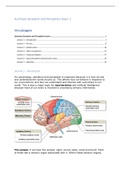Summary Sensation and Perception Exam 1
Inhoudsopgave
Summary Sensation and Perception Exam 1..................................................................................................... 1
Lecture 1 – Introduction ..................................................................................................................................... 1
Lecture 2 – the eye ............................................................................................................................................. 8
Lecture 3 – Spatial vision .................................................................................................................................. 16
Lecture 4 – object recognition .......................................................................................................................... 22
Lecture 5 – Colour perception........................................................................................................................... 27
Lecture 6 – space perception and binocular vision ........................................................................................... 32
Lecture 7 – Attention ........................................................................................................................................ 35
Lecture 1 – Introduction
For psychology, sensation and perception is important because it is how we see
and understand the world around us. This affects how we behave in response to
our environment, and how we understand and interact with everything in our
world. This is also a major topic for neuroscience and artificial intelligence
because most of our brain is involved in processing sensory information.
The senses → we have five senses: sight, sound, taste, smell and touch. Each
of these has a sensory organ associated with it. Within these sensory organs,
,there are specific sensory receptor neurons that interact with something
physical in the outside world.
Sense Sensory organ
Vision (sight) Eyes (retina)
Hearing (audition) Ears (Cochlea)
Taste (gustation) Tongue (taste buds)
Smell (olfaction) Nose (olfactory epithelium)
Touch (somatosensorial) Skin etc. (many)
Balance (vestibular) Vestibular labyrinths
Our sense of touch is not a single sense. Much relies on the skin, there are
many distinct sensory receptors involved, each producing distinct sensations. For
example: light touch, deep touch, stretch, heat, cold or pain.
A single type of sensory receptor’s activity can be analyzed in multiple
ways, so that there are multiple parts within each sense.
For example, vision → all of these different aspects begin in the same place, the
eye, and share early processing stages. But then the are separated into different
functions performed by different pathways.
- The eye and early visual pathways
o Form (shape)
o Motion
o Colour
o Depth and distance
o Cognitive influences: attention and awareness
Similarly, hearing all starts with the ear, but then has separate analyses for the
sounds location and frequency structure.
Why so much vision?
- Vision is the primary sense in humans
o Almost every action we make is guided by vision
- We do a lot of analysis of vision
o Object recognition
o Form and colour
o Space and motion
o Location, motion, distance and depth
As a result, a huge proportion of our brain is devoted to visual processing.
Conversely, only small specific brain areas are involved in human touch
processing and auditory processing. Very small areas are involved in taste, smell
and vestibular processing. It is also easy to study.
,Dualism or monism?
Dualism → humans have mind or spirit separate from the physical body
Monism → the mind is an aspect of the body, held in the brain and nervous
system. This course will take this view.
Sensation and perception
Sensation → a translation of the external physical environment into a pattern of
neural activity (by a sensory organ).
Perception: analysis of this neural activity to understand the environment and
guide behavior.
Sensation and perception reflect interactions between our sensory organs and
physical properties of the world, so they are:
- Dependent on physical properties of the world
- Limited by the physical properties of our sensors
We may feel that we perceive the world as it truly is. But in fact we don’t
perceive the world accurately at all. Understanding the physical and neural basis
of perception often reveals why we perceive things as we do.
Dependence on physical properties of the world
Visible light has a short wavelength and does not reflect from most surfaces, so
it does not travel around corners.
However, sound has a longer wavelength and reflects more easily, so we can
generally hear around corners fairly well: we can hear this car around a corner,
but can only see around the corner with a mirror.
Limitations of the physical properties of our sensors
The human eye is only sensitive to a short range of wavelengths of light, part of
a much larger electromagnetic spectrum. Honeybees can see ultraviolet
wavelengths which humans can’t, changing the appearance of a flower.
Sensation and perception have evolved to help us survive and reproduce, so
they are:
- Optimized for useful representation of the environment
- Influenced by interpretation: context and experience
- Dependent on limited resources of attention and awareness (we can
sometimes receive more input than we can process)
How to study perception?
, - A translation of the physical environment into a pattern of neural activity
can be used by our brain to guide behavior
- So to study perception experimentally:
o Change the physical environment of a human or animal (sensory
stimulus)
o Measure the resulting behavior or
o Measure the resulting change in neural activity
Psychological approach (Weber and Fechner):
- Quantitative measurements of behavior resulting from perception
- The scientific study of the relation between stimulus and sensation
- Best understood as testing whether subjects perceive a difference between
two stimuli
- We can just notice the extra light of one candle when added to three
candles, but not when added to the light of six candles. Against six
candles, we need two extra candles.
- So, if we determine the just noticeable difference, the change in the
environment that we can only just perceive, its size depends on the
stimulus that is being compared.





